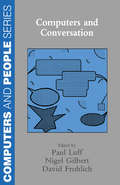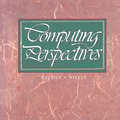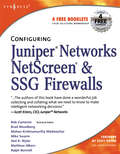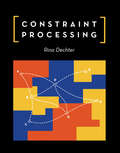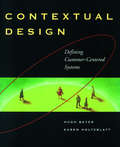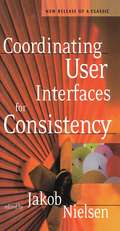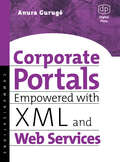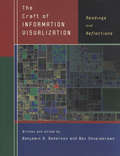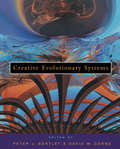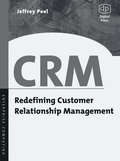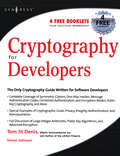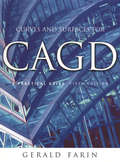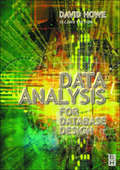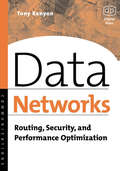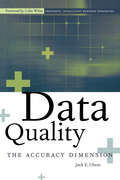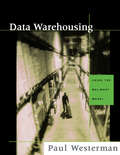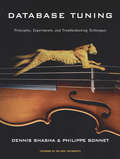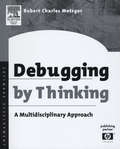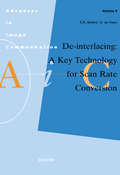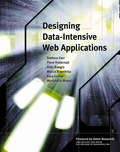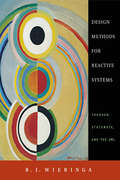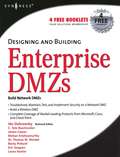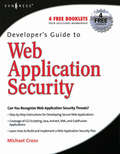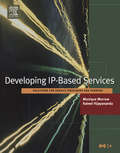- Table View
- List View
Computers and Conversation
by Paul Luff David Frohlich Nigel G. GilbertIn the past few years a branch of sociology, conversation analysis, has begun to have a significant impact on the design of human*b1computer interaction (HCI). The investigation of human*b1human dialogue has emerged as a fruitful foundation for interactive system design.****This book includes eleven original chapters by leading researchers who are applying conversation analysis to HCI. The fundamentals of conversation analysis are outlined, a number of systems are described, and a critical view of their value for HCI is offered.****Computers and Conversation will be of interest to all concerned with HCI issues--from the advanced student to the professional computer scientist involved in the design and specification of interactive systems.
Computing Perspectives (ISSN)
by Maurice V. WilkesIn this insightful collection of essays, Maurice Wilkes shares his unique perspective on the development of computers and the current state of the art. These enlightening essays discuss the foundational ideas behind modern computing and provide a solid grounding for the appreciation of emerging computer technologies.Wilkes, one of the founders of computing, has provided enormous contributions to the development of computers, including the design and construction of the EDSAC computer and early development of programming for a stored program computer. He was responsible for the concept of microprogramming. Wilkes also wrote the first paper to appear on cache memories and was an early worker in the field of wide bandwidth local area networks. In 1992 he was awarded the prestigious Kyoto Prize for Advanced Technology.These essays will be of interest to everyone involved with computers and how they arrived at their present state. Wilkes presents his perspectives with keen historical sensibility and engineering practicality. Readers are invited to consider these observations and form their own perspectives on the present state of the computer art.
Configuring Juniper Networks NetScreen and SSG Firewalls
by Rob Cameron Chris Cantrell Anne Hemni Lisa LorenzinJuniper Networks Secure Access SSL VPN appliances provide a complete range of remote access appliances for the smallest companies up to the largest service providers. This comprehensive configuration guide will allow system administrators and security professionals to configure these appliances to allow remote and mobile access for employees. If you manage and secure a larger enterprise, this book will help you to provide remote and/or extranet access for employees, partners, and customers from a single platform.Configure Juniper’s Instant Virtual Extranet (IVE)Install and set up IVE through either the command line interface (CLI) or Web-based consoleMaster the "3 Rs": Realms, Roles, and ResourcesRealize the potential of the "3Rs" for endpoint security, sign-in policies, and authorization of serversGet Inside both the Windows and Java Versions of Secure Application Manager (SAM)Learn to implement SAM, manage the end-user experience, and troubleshoot SAM in the fieldIntegrate IVE with Terminal Services and CitrixEnable terminal services proxy and configure role options, configure Citrix using a custom ICA, configure terminal services resource policies and profiles, and configure terminal services and Citrix using a hosted Java appletEnsure Endpoint SecurityUse Host Checker, Cache Cleaner, Secure Virtual Workspace, and IVE/IDP integration to secure your networkManage the Remote Access Needs of Your OrganizationConfigure Web access, file access and telnet/SSH access for remote users and officesConfigure Core Networking Components through the System MenuCreate clusters, manage virtual systems, and monitor logs, reports, and alertsCreate Bullet-Proof Sign-in PoliciesCreate standard and custom sign-in pages for both user and administrator access and Secure Meeting pagesUse the IVE for Log-Related TasksPerform log filtering, log management, syslog exporting, SNMP management, and system resource monitoring and reporting.
Constraint Processing (The Morgan Kaufmann Series in Artificial Intelligence)
by Rina DechterConstraint satisfaction is a simple but powerful tool. Constraints identify the impossible and reduce the realm of possibilities to effectively focus on the possible, allowing for a natural declarative formulation of what must be satisfied, without expressing how. The field of constraint reasoning has matured over the last three decades with contributions from a diverse community of researchers in artificial intelligence, databases and programming languages, operations research, management science, and applied mathematics. Today, constraint problems are used to model cognitive tasks in vision, language comprehension, default reasoning, diagnosis, scheduling, temporal and spatial reasoning. In Constraint Processing, Rina Dechter, synthesizes these contributions, along with her own significant work, to provide the first comprehensive examination of the theory that underlies constraint processing algorithms. Throughout, she focuses on fundamental tools and principles, emphasizing the representation and analysis of algorithms.Examines the basic practical aspects of each topic and then tackles more advanced issues, including current research challengesBuilds the reader's understanding with definitions, examples, theory, algorithms and complexity analysisSynthesizes three decades of researchers work on constraint processing in AI, databases and programming languages, operations research, management science, and applied mathematics
Constraints, Language and Computation (Cognitive Science)
by M. A. Rosner C. J. Rupp Torrence JohnsonConstraint-based linguistics is intersected by three fields: logic, linguistics, and computer sciences. The central theme that ties these different disciplines together is the notion of a linguistic formalism or metalanguage. This metalanguage has good mathematical properties, is designed to express descriptions of language, and has a semantics that can be implemented on a computer. Constraints, Language and Computation discusses the theory and practice of constraint-based computational linguistics. The book captures both the maturity of the field and some of its more interesting future prospects during a particulary important moment of development in this field.
Contextual Design: Defining Customer-Centered Systems (Interactive Technologies)
by Karen Holtzblatt Hugh BeyerThis book introduces a customer-centered approach to business by showing how data gathered from people while they work can drive the definition of a product or process while supporting the needs of teams and their organizations. This is a practical, hands-on guide for anyone trying to design systems that reflect the way customers want to do their work. The authors developed Contextual Design, the method discussed here, through their work with teams struggling to design products and internal systems. In this book, you'll find the underlying principles of the method and how to apply them to different problems, constraints, and organizational situations.Contextual Design enables you to+ gather detailed data about how people work and use systems + develop a coherent picture of a whole customer population + generate systems designs from a knowledge of customer work+ diagram a set of existing systems, showing their relationships, inconsistencies, redundancies, and omissions
Coordinating User Interfaces for Consistency (Interactive Technologies)
by Jakob NielsenIn the years since Jakob Nielsen's classic collection on interface consistency first appeared, much has changed, and much has stayed the same. On the one hand, there's been exponential growth in the opportunities for following or disregarding the principles of interface consistency-more computers, more applications, more users, and of course the vast expanse of the Web. On the other, there are the principles themselves, as persistent and as valuable as ever. In these contributed chapters, you'll find details on many methods for seeking and enforcing consistency, along with bottom-line analyses of its benefits and some warnings about its possible dangers. Most of what you'll learn applies equally to hardware and software development, and all of it holds real benefits for both your organization and your users.Begins with a new preface by the collection's distinguished editorDetails a variety of methods for attaining interface consistency, including central control, user definitions, exemplary applications, shared code, and model analysisPresents a cost-benefits analysis of organizational efforts to promote and achieve consistencyExamines and appraises the dimensions of consistency-consistency within an application, across a family of applications, and beyondMakes the case for some unexpected benefits of interface consistency while helping you avoid the risks it can sometimes entailConsiders the consistency of interface elements other than screen designIncludes case studies of major corporations that have instituted programs to ensure the consistency of their products
Corporate Portals Empowered with XML and Web Services
by Anura GurugeFollowing the humbling of the 'dot.coms' it is well implemented corporate portals that are ushering in a new and prosperous era of e-business. Corporate Portals Empowered with XML and Web Services provides decision makers with a clear and concise explanation of what portals are all about, why you really need a portal strategy, how you go about implementing one, and the issues you have to encounter and surmount. Guruge shows how you can successfully use XML and web services to empower your portals for collaboration, knowledge management, CRM, ERP and supply chain management.· Extensive examples of corporate portals illustrate the viability of the technology· Architectural and network diagrams show detailed portal implementations· Comprehensive references to guides, solutions, products and terminology leverage living outside resources
The Craft of Information Visualization: Readings and Reflections (Interactive Technologies)
by Ben Shneiderman Benjamin B. BedersonSince the beginning of the computer age, researchers from many disciplines have sought to facilitate people's use of computers and to provide ways for scientists to make sense of the immense quantities of data coming out of them. One gainful result of these efforts has been the field of information visualization, whose technology is increasingly applied in scientific research, digital libraries, data mining, financial data analysis, market studies, manufacturing production control, and data discovery.This book collects 38 of the key papers on information visualization from a leading and prominent research lab, the University of Maryland’s Human-Computer Interaction Lab (HCIL). Celebrating HCIL’s 20th anniversary, this book presents a coherent body of work from a respected community that has had many success stories with its research and commercial spin-offs. Each chapter contains an introduction specifically written for this volume by two leading HCI researchers, to describe the connections among those papers and reveal HCIL’s individual approach to developing innovations.*Presents key ideas, novel interfaces, and major applications of information visualization tools, embedded in inspirational prototypes.*Techniques can be widely applied in scientific research, digital libraries, data mining, financial data analysis, business market studies, manufacturing production control, drug discovery, and genomic studies.*Provides an "insider" view to the scientific process and evolution of innovation, as told by the researchers themselves.*This work comes from the prominent and high profile University of Maryland's Human Computer Interaction Lab
Creative Evolutionary Systems (The Morgan Kaufmann Series in Artificial Intelligence)
by David W. Corne Peter J. BentleyThe use of evolution for creative problem solving is one of the most exciting and potentially significant areas in computer science today. Evolutionary computation is a way of solving problems, or generating designs, using mechanisms derived from natural evolution. This book concentrates on applying important ideas in evolutionary computation to creative areas, such as art, music, architecture, and design. It shows how human interaction, new representations, and approaches such as open-ended evolution can extend the capabilities of evolutionary computation from optimization of existing solutions to innovation and the generation of entirely new and original solutions.This book takes a fresh look at creativity, exploring what it is and how the actions of evolution can resemble it. Examples of novel evolved solutions are presented in a variety of creative disciplines. The editors have compiled contributions by leading researchers in each discipline. If you are a savvy and curious computing professional, a computer-literate artist, musician or designer, or a specialist in evolutionary computation and its applications, you will find this a fascinating survey of the most interesting work being done in the area today.* Explores the use of evolutionary computation to generate novel creations including contemporary melodies, photo-realistic faces, jazz music in collaboration with a human composer, architectural designs, working electronic circuits, novel aircraft maneuvers, two- and three-dimensional art, and original proteins.* Presents resulting designs in black-and-white and color illustrations.* Includes a twin-format audio/CD-ROM with evolved music and hands-on activities for the reader, including evolved images, animations, and source-code related to the text.* Describes in full the methods used so that readers with sufficient skill and interest can replicate the work and extend it.* Is written for a general computer science audience, providing coherent and unified treatment across multiple disciplines.
CRM: Redefining Customer Relationship Management
by Jeffrey PeelIn CRM, Jeffrey Peel defines Customer Relationship Management in a radical new way by putting communications at the center. In the past, CRM was mostly about the technology, not about the customer. In this book, Peel talks about a new ethos that is beginning to fundamentally change the way organizations do business. At a technology level, CRM is increasingly about conjoined best-of-breed applications delivered via portal technologies. At a business level, it is beginning to invade traditional territories occupied by brand management or customer support. Peel shows companies how to make the shift to the new paradigm.· Defines the nature of new CRM niche solutions· Provides entirely new types of functionality that mesh seamlessly· Describes solutions focused solely on the needs of the customer
Cryptography for Developers
by Tom St DenisThe only guide for software developers who must learn and implement cryptography safely and cost effectively.Cryptography for Developers begins with a chapter that introduces the subject of cryptography to the reader. The second chapter discusses how to implement large integer arithmetic as required by RSA and ECC public key algorithms The subsequent chapters discuss the implementation of symmetric ciphers, one-way hashes, message authentication codes, combined authentication and encryption modes, public key cryptography and finally portable coding practices. Each chapter includes in-depth discussion on memory/size/speed performance trade-offs as well as what cryptographic problems are solved with the specific topics at hand.The author is the developer of the industry standard cryptographic suite of tools called LibTomA regular expert speaker at industry conferences and events on this development
Curves and Surfaces for CAGD: A Practical Guide (The Morgan Kaufmann Series in Computer Graphics)
by Gerald FarinThis fifth edition has been fully updated to cover the many advances made in CAGD and curve and surface theory since 1997, when the fourth edition appeared. Material has been restructured into theory and applications chapters. The theory material has been streamlined using the blossoming approach; the applications material includes least squares techniques in addition to the traditional interpolation methods. In all other respects, it is, thankfully, the same. This means you get the informal, friendly style and unique approach that has made Curves and Surfaces for CAGD: A Practical Guide a true classic. The book's unified treatment of all significant methods of curve and surface design is heavily focused on the movement from theory to application. The author provides complete C implementations of many of the theories he discusses, ranging from the traditional to the leading-edge. You'll gain a deep, practical understanding of their advantages, disadvantages, and interrelationships, and in the process you'll see why this book has emerged as a proven resource for thousands of other professionals and academics.Provides authoritative and accessible information for those working with or developing computer-aided geometric design applicationsCovers all significant CAGD curve and surface design techniques-from the traditional to the experimentalIncludes a new chapter on recursive subdivision and triangular meshesPresents topical programming exercises useful to professionals and students alike
Data Analysis for Database Design
by David HoweData analysis for database design is a subject of great practical value to systems analysts and designers. This classic text has been updated to include chapters on distributed database systems, query optimisation and object-orientation.The SQL content now includes features of SQL92 and SQL 99. With new databases coming online all the time and the general expansion of the information age, it is increasingly important to ensure that the analysis and model of a database design is accurate and robust. This is an ideal book for helping you to ensure that your database is well designed and therefore user friendly.Increased material on SQL including the latest developmentsPractical approach to explaining techniques and conceptsContains many questions and answer pointers
Data Networks: Routing, Security, and Performance Optimization
by Tony KenyonData Networks builds on the foundation laid in Kenyon's first book, High-Performance Data Network Design, with expanded coverage of routing, security, multicasting, and advanced design topics such as performance optimization and fault tolerance. Kenyon provides strategies for overcoming some of the most challenging problems in network design and management. He provides clear, specific solutions for day-to-day problems facing network designers and IT managers. In this book, you will find optimization advice from an experienced practitioner that you can put to work in your own system.As security and network performance become more and more critical to a company's success, the system administrator's job becomes even more difficult. Use the principles, tips, and techniques Kenyon offers here to enhance and protect the flow of data within your enterprise.· Covers Addressing, Routing, Multicasting, and Quality of Service (QoS) design for enterprise network design.· Extensive coverage on relevant Security Technologies and Virtual Private Network (VPN) implementation· Provides advanced coverage on Risk Assessment, Availability Analysis, Fault Tolerance, Disaster Recovery, and Network Optimization.
Data Quality: The Accuracy Dimension (The Morgan Kaufmann Series in Data Management Systems)
by Jack E. OlsonData Quality: The Accuracy Dimension is about assessing the quality of corporate data and improving its accuracy using the data profiling method. Corporate data is increasingly important as companies continue to find new ways to use it. Likewise, improving the accuracy of data in information systems is fast becoming a major goal as companies realize how much it affects their bottom line. Data profiling is a new technology that supports and enhances the accuracy of databases throughout major IT shops. Jack Olson explains data profiling and shows how it fits into the larger picture of data quality.* Provides an accessible, enjoyable introduction to the subject of data accuracy, peppered with real-world anecdotes. * Provides a framework for data profiling with a discussion of analytical tools appropriate for assessing data accuracy. * Is written by one of the original developers of data profiling technology. * Is a must-read for any data management staff, IT management staff, and CIOs of companies with data assets.
Data Warehousing: Using the Wal-Mart Model (The Morgan Kaufmann Series in Data Management Systems)
by Paul WestermanAt 70 terabytes and growing, Wal-Mart's data warehouse is still the world's largest, most ambitious, and arguably most successful commercial database. Written by one of the key figures in its design and construction, Data Warehousing: Using the Wal-Mart Model gives you an insider's view of this enormous project. Continuously drawing from this example, the author teaches you the general principles and specific techniques you need to understand to be a valuable part of your organization's own data warehouse project, however large or small. You'll emerge with a practical understanding of both the business and technical aspects of building a data warehouse for storing and accessing data in a strategically useful way.What further sets this book apart is its focus on the informational needs of retail companies-including both market and organizational issues that affect the data's collection and use. If retail is your field, this book will prove especially valuable as you develop and implement your company's ideal data warehouse solution.* Written by a member of the team of four engineers who designed and built the Wal-Mart Data Warehouse database, a team whose database design was recognized internally in 1991 by Wal-Mart with the company's Team Innovational Technical award.* Provides essential information for project managers, consultants, data warehouse managers, and data architects.* Takes an in-depth look at a wide range of technical issues, including architecture, construction approaches, tool selection, database system selection, and maintenance.* Addresses issues specific to retail business: vendors, inventory, sales analysis, geography, article categories, and more.* Explains how to determine business requirements at the outset of the project-and how to develop return on investment analyses after the warehouse has been brought online.
Database Tuning: Principles, Experiments, and Troubleshooting Techniques (The Morgan Kaufmann Series in Data Management Systems)
by Dennis Shasha Philippe BonnetTuning your database for optimal performance means more than following a few short steps in a vendor-specific guide. For maximum improvement, you need a broad and deep knowledge of basic tuning principles, the ability to gather data in a systematic way, and the skill to make your system run faster. This is an art as well as a science, and Database Tuning: Principles, Experiments, and Troubleshooting Techniques will help you develop portable skills that will allow you to tune a wide variety of database systems on a multitude of hardware and operating systems. Further, these skills, combined with the scripts provided for validating results, are exactly what you need to evaluate competing database products and to choose the right one.Forward by Jim Gray, with invited chapters by Joe Celko and Alberto LernerIncludes industrial contributions by Bill McKenna (RedBrick/Informix), Hany Saleeb (Oracle), Tim Shetler (TimesTen), Judy Smith (Deutsche Bank), and Ron Yorita (IBM)Covers the entire system environment: hardware, operating system, transactions, indexes, queries, table design, and application analysisContains experiments (scripts available on the author's site) to help you verify a system's effectiveness in your own environmentPresents special topics, including data warehousing, Web support, main memory databases, specialized databases, and financial time seriesDescribes performance-monitoring techniques that will help you recognize and troubleshoot problems
Debugging by Thinking: A Multidisciplinary Approach (HP Technologies)
by Robert Charles MetzgerDebugging by Thinking: A Multi-Disciplinary Approach is the first book to apply the wisdom of six disciplines—logic, mathematics, psychology, safety analysis, computer science, and engineering—to the problem of debugging. It uses the methods of literary detectives such as Sherlock Holmes, the techniques of mathematical problem solving, the results of research into the cognitive psychology of human error, the root cause analyses of safety experts, the compiler analyses of computer science, and the processes of modern engineering to define a systematic approach to identifying and correcting software errors.* Language Independent Methods: Examples are given in Java and C++* Complete source code shows actual bugs, rather than contrived examples* Examples are accessible with no more knowledge than a course in Data Structures and Algorithms requires * A "thought process diary" shows how the author actually resolved the problems as they occurred
De-interlacing: A Key Technology for Scan Rate Conversion (ISSN #Volume 9)
by E.B. Bellers G. de Haan'To interlace or not to interlace' is a hot issue currently. Traditionally interlace has been part of the video standard as it reduces the transmission and display demands, while hardly affecting the perceived quality of the pictures.With the current explosion of new video formats due to emerging technologies as multimedia PC's, videotelephony and flat matrix display the question whether or not interlace is a relict from the past is more relevant than ever.This book provides a broad overview of advanced motion estimation and de-interlacing techniques to enable a profound scientific basis for answering the above question. An extensive evaluation of the algorithms, including many screen photographs is an imt part of the book. But also system questions, such as whether interlace is a good choice in combination with modern video compression methods (MPEG), and which currently would be the optional choice for a display format are extensively treated.The combination of scientific profoundness and completions, with the focus on practical hot issues, makes the book unique in its kind.
Designing Data-Intensive Web Applications (The Morgan Kaufmann Series in Data Management Systems)
by Stefano Ceri Piero Fraternali Aldo Bongio Marco Brambilla Sara Comai Maristella MateraThe most prominent Web applications in use today are data-intensive. Scores of database management systems across the Internet access and maintain large amounts of structured data for e-commerce, on-line trading, banking, digital libraries, and other high-volume sites.Developing and maintaining these data-intensive applications is an especially complex, multi-disciplinary activity, requiring all the tools and techniques that software engineering can provide. This book represents a breakthrough for Web application developers. Using hundreds of illustrations and an elegant intuitive modeling language, the authors—all internationally-known database researchers—present a methodology that fully exploits the conceptual modeling approach of software engineering, from idea to application. Readers will learn not only how to harness the design technologies of relational databases for use on the Web, but also how to transform their conceptual designs of data-intensive Web applications into effective software components.* A fully self-contained introduction and practitioner's guide suitable for both technical and non-technical members of staff, as well as students.* A methodology, development process, and notation (WebML) based on common practice but optimized for the unique challenges of high-volume Web applications.* Completely platform- and product-independent; even the use of WebML is optional.* Based on well-known industry standards such as UML and the Entity Relationship Model.* Enhanced by its own Web site (http://www.webml.org), containing additional examples, papers, teaching materials, developers' resources, and exercises with solutions.
Design Methods for Reactive Systems: Yourdon, Statemate, and the UML (The Morgan Kaufmann Series in Software Engineering and Programming)
by R. J. WieringaDesign Methods for Reactive Systems describes methods and techniques for the design of software systems—particularly reactive software systems that engage in stimulus-response behavior. Such systems, which include information systems, workflow management systems, systems for e-commerce, production control systems, and embedded software, increasingly embody design aspects previously considered alone—such as complex information processing, non-trivial behavior, and communication between different components—aspects traditionally treated separately by classic software design methodologies. But, as this book illustrates, the software designer is better served by the ability to intelligently pick and choose from among a variety of techniques according to the particular demands and properties of the system under development.Design Methods for Reactive Systems helps the software designer meet today's increasingly complex challenges by bringing together specification techniques and guidelines proven useful in the design of a wide range of software systems, allowing the designer to evaluate and adapt different techniques for different projects. Written in an exceptionally clear and insightful style, Design Methods for Reactive Systems is a book that students, engineers, teachers, and researchers will undoubtedly find of great value.Shows how the techniques and design approaches of the three most popular design methods can be combined in a flexible, problem-driven manner.Pedagogical features include summaries, rehearsal questions, exercises, discussion questions, and numerous case studies.
Designing and Building Enterprise DMZs
by Hal FlynnThis is the only book available on building network DMZs, which are the cornerstone of any good enterprise security configuration. It covers market-leading products from Microsoft, Cisco, and Check Point.One of the most complicated areas of network technology is designing, planning, implementing, and constantly maintaining a demilitarized zone (DMZ) segment. This book is divided into four logical parts. First the reader will learn the concepts and major design principles of all DMZs. Next the reader will learn how to configure the actual hardware that makes up DMZs for both newly constructed and existing networks. Next, the reader will learn how to securely populate the DMZs with systems and services. The last part of the book deals with troubleshooting, maintaining, testing, and implementing security on the DMZ.The only book published on Network DMZs on the components of securing enterprise networksThis is the only book available on building network DMZs, which are the cornerstone of any good enterprise security configuration. It covers market-leading products from Microsoft, Cisco, and Check PointProvides detailed examples for building Enterprise DMZs from the ground up and retro-fitting existing infrastructures
Developer's Guide to Web Application Security
by Michael CrossOver 75% of network attacks are targeted at the web application layer. This book provides explicit hacks, tutorials, penetration tests, and step-by-step demonstrations for security professionals and Web application developers to defend their most vulnerable applications.This book defines Web application security, why it should be addressed earlier in the lifecycle in development and quality assurance, and how it differs from other types of Internet security. Additionally, the book examines the procedures and technologies that are essential to developing, penetration testing and releasing a secure Web application. Through a review of recent Web application breaches, the book will expose the prolific methods hackers use to execute Web attacks using common vulnerabilities such as SQL Injection, Cross-Site Scripting and Buffer Overflows in the application layer. By taking an in-depth look at the techniques hackers use to exploit Web applications, readers will be better equipped to protect confidential.The Yankee Group estimates the market for Web application-security products and services will grow to $1.74 billion by 2007 from $140 million in 2002 Author Michael Cross is a highly sought after speaker who regularly delivers Web Application presentations at leading conferences including: Black Hat, TechnoSecurity, CanSec West, Shmoo Con, Information Security, RSA Conferences, and more
Developing IP-Based Services: Solutions for Service Providers and Vendors (ISSN)
by Monique Morrow Kateel VijayanandaOffering new services is a great way for your organization to drive traffic and boost revenue, and what better foundation for these services than IP? This much is a given. The difficulty is uniting business and technical perspectives in a cohesive development and deployment process. Meeting this challenge is the focus of Developing IP-Based Services. The only book of its kind devoted exclusively to IP-based services, it provides a blueprint for all the engineers, managers, and analysts who must come together to build these services and bring them online.Inside, you'll find just the right balance of business and technical coverage, introduced with a lucid discussion of the principles of service development and wrapped up with three case studies illustrating effective provisioning in today's marketplace. Read the chapters relating to your role, and you'll play it more successfully. Have your team read the entire book, and you'll achieve a level of collaboration and shared understanding that will quickly accrue to the bottom line.* Valuable insight from authors with extensive service provisioning and product development experience. * Written for business and technical readers at a wide range of companies, including established telecoms, ISPs, ASPs, Clecs, bandwidth brokers, and vendors. * Probes the business issues that will make or break your effort, including shortening the development cycle and choosing a competitive model. * Provides the technical coverage required for successful implementation, according to the terms of the business model you choose. * Focuses on the IP technologies that offer your service and its users the greatest value, including MPLS, Voice Over IP, and multicast. * Helps you meet tough challenges relating to security and Quality of Service. * Concludes with case studies illustrating successful service development and deployment in three companies.
